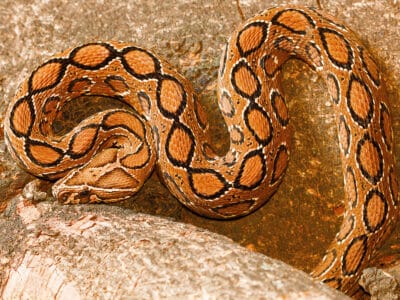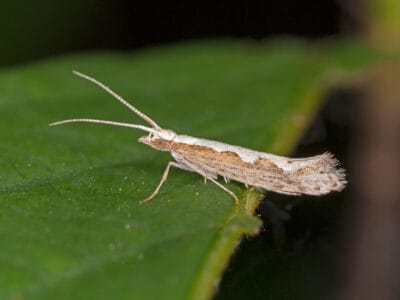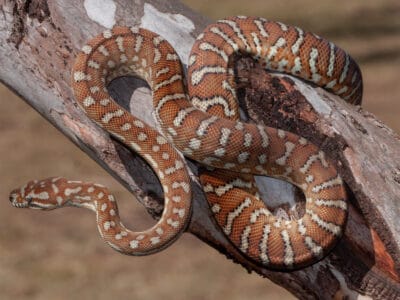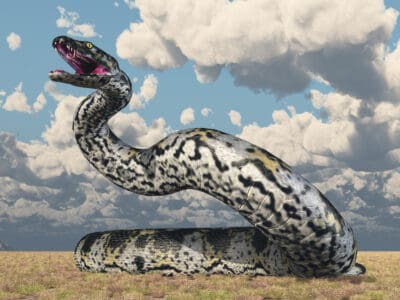Wels Catfish
.jumbotron {
background-image: url(“https://a-z-animals.com/media/2022/03/Wels-Catfish-3-400×300.jpg”);
}
}
@media only screen and (min-width: 641px) and (max-width: 920px) {
.jumbotron {
background-image: url(“https://a-z-animals.com/media/2022/03/Wels-Catfish-3-470×370.jpg”);
}
}
@media only screen and (min-width: 921px) {
.jumbotron {
background-image: url(“https://a-z-animals.com/media/2022/03/Wels-Catfish-3.jpg”);
}
}
Wels Catfish
Silurus glanis
The wels catfish is among the largest freshwater fish in the world.
Wels Catfish Scientific Classification
- Kingdom
- Animalia
- Phylum
- Chordata
- Class
- Actinopterygii
- Order
- Siluriformes
- Family
- Siluridae
- Genus
- Silurus
- Scientific Name
- Silurus glanis
Read our Complete Guide to Classification of Animals.
Wels Catfish Conservation Status
Wels Catfish Facts
- Prey
- Snails, worms, crustaceans, insects, fish, and birds
- Group Behavior
-
- Solitary
- Fun Fact
- The wels catfish is among the largest freshwater fish in the world.
- Estimated Population Size
- Unknown
- Biggest Threat
- Overfishing
- Most Distinctive Feature
- The barbels (whiskers) on the face
- Other Name(s)
- Sheatfish
- Gestation Period
- 3-10 days
- Optimum pH Level
- unknown
- Habitat
- rivers and lakes
- Predators
- Humans and pike
- Diet
- Omnivore
- Type
- ray-finned fish
- Common Name
- wels catfish
- Number Of Species
- 1
This post may contain affiliate links to our partners like Chewy, Amazon, and others. Purchasing through these helps us further the A-Z Animals mission to educate about the world’s species..

Spiders that fly! Fish that walk! And 1000+ more incredible animals. Discover them all for FREE
.photo-gallery {
–margin: 0px auto 0px;
–padding: 0px 0px 0px 0px;
}
.gallery-link {
background-image: url(“https://a-z-animals.com/media/2022/03/wels-catfish-1-1024×614.jpg”);
background-repeat: no-repeat;
background-size: cover;
background-position: center;
height: 500px;
justify-content: center;
text-align: center;
align-items: center;
display: flex;
border: 2px solid #000;
}
.gallery-link img {
height: 50%;
}
@media only screen and (max-width: 768px) {
.gallery-link {
height: 300px !important;
}
}
View all of the Wels Catfish images!
The wels catfish is among the giants of the freshwater world.
Despite their size, this massive behemoth is otherwise just like most catfish. They prowl around the bottom of freshwater rivers and lakes in search of food to eat. Popular in both commercial and recreational fishing, they are sometimes caught by people for the taste of their meat.
4 Wels Catfish Facts
- The common names wels appears to come from old Germanic. It can be traced back even farther to an ancient European word meaning sheatfish (the alternative name for this type of catfish).
- The wels catfish is thought be exceptionally sensitive to chemical signals in the water. It also has the ability to detect fine movements of water from nearby prey.
- The wels catfish lives in the cooling ponds of the Chernobyl Nuclear Power Plant. While these fish grow larger than anywhere else, it’s not because they’re mutated from the Chernobyl radiation. It’s because they are allowed to fully grow without being disturbed by humans. Despite the radiation, the Chernobyl populations appear to be healthy and thriving.
- Rare attacks on humans have been reported, but no one has lost their life from this species.
Wels Catfish Classification and Scientific Name
The scientific name of the wels catfish is Silurus glanis. This name is thought to derive from an ancient Greek word meaning a large river fish. Wels catfish belongs a genus that also includes other very large species, including the Amur catfish and Aristotle’s catfish.
Wels Catfish Appearance
The most prominent characteristic of the wels catfish is its enormous size. This giant of the river can reach up to 10 feet long and weigh a record 500 pounds. This would make it the second largest freshwater fish in all of Europe behind the beluga sturgeon. But most full-grown specimens are more like 4 to 6 feet long and weigh 200 pounds.
The wels catfish is characterized by an extremely long, scale-less body with flattened tail, wide mouth, an exceptionally long anal fin running along the stomach, and a kind of mottled gray or greenish brown skin (albino specimens have been reported as well). They have two long barbels (or “whiskers”) on the upper jaw and four shorter barbels on the lower jaw; these help the fish find their way in the water and search for food items in the sand.
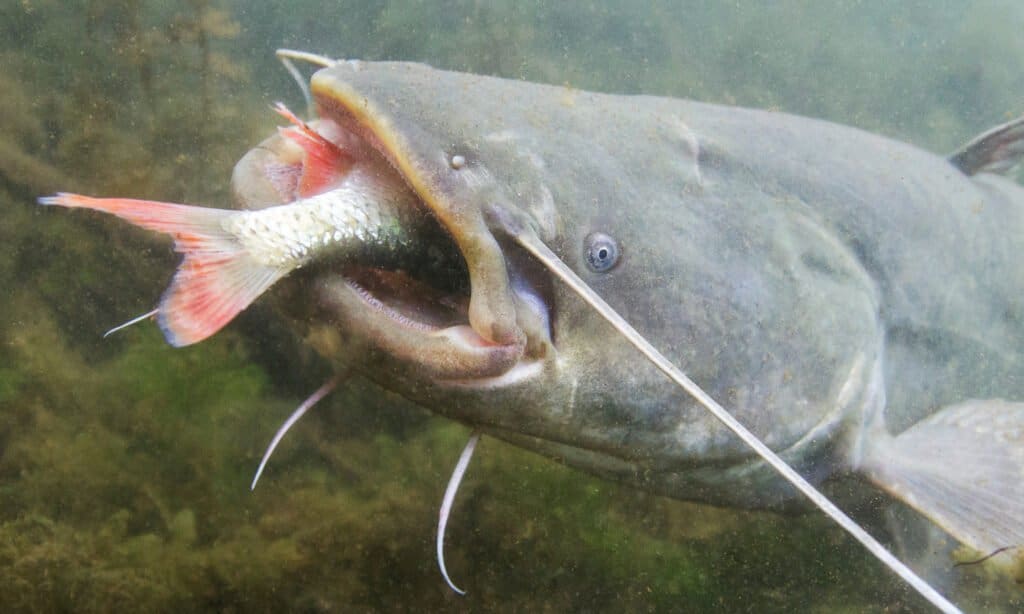
Rostislav Stefanek/Shutterstock.com
Wels Catfish Distribution, Population, and Habitat
Wels catfish is native to the freshwater rivers and lakes of Europe and Asia. This species was introduced into Western Europe as a sport fish and even as far east as China. It is also found near coastal waters of the Baltic, Black, and Caspian Seas. According to the IUCN Red List, they are considered to be a species of least concern. However, this masks wide regional differences in population numbers. In some areas it appears to be threatened by overfishing and habitat changes. Low genetic diversity is also contributing to the problem. Unfortunately, accurate population numbers are not available.
Wels Catfish Predators and Prey
This fish sits near the top of the food chain. It feeds on a wide variety of different animals and in turn has few predators. Like many catfish, it sifts along the bottom of the water or ambushes prey in a sudden strike.
What eats the wels catfish?
Due to their enormous size, a full-grown wels catfish have few natural predators in the wild. Humans are about the only species to hunt them. Northern pike will eat juveniles as well.
What does the wels catfish eat?
A full-grown wels catfish will consume snails, worms, crustaceans, aquatic insects, and smaller fish. They are even known to consume ducks, crayfish, frogs, rats, and snakes as well, even leaping out of the water to consume an unsuspecting animal. The suction force of their mouths helps them capture prey in the water. Young catfish fry, by contrast, mostly feed on plankton during the first year of life.
Wels Catfish Reproduction and Lifespan
Unfortunately, there is a lot we still don’t understand about the reproduction and courtship behavior of the wels catfish. The spawning season seems to take place between May and July of each year. Like many other types of catfish, the male will create a nest in the sand where the female will lay its eggs. It’s estimated that the female can lay some 30,000 eggs per every kilogram (2.2 pounds) of body weight. The male will then release his sperm into the water for the purpose of fertilizing them. During the three to 10 day gestation period, the male will stand guard over the eggs.
After hatching, the fry will feed on plankton and grow quickly. They can easily reach up to 10 pounds in the first year alone. The male will reach sexual maturity in about three years, whereas the female can take four years instead. The record lifespan in the wild is known to be 80 years, but 20 to 30 years is a more typical age of death due partly to diseases and hunting.
Wels Catfish in Fishing and Cooking
The wels catfish is valued in some circles as an important game fish for expert hunters who have the proper equipment to reel in this behemoth. The boneless white meat is low in fat and largely considered to be a delicacy.
View all 74 animals that start with W
Wels Catfish FAQs (Frequently Asked Questions)
Where are wels catfish found?
They are found in the freshwater river and lake systems throughout most of Europe.
Do wels catfish taste good?
Many people do enjoy the taste of the meat. The flesh is similar to many other types of catfish.
Are there any wels catfish in America?
The wels catfish is not currently established within America. It is prohibited from the waterways of most states in America.
Are wels catfish invasive?
If it’s released into foreign waters, the wels catfish can outcompete local species for food and resources. This would make it an invasive species.
Are wels catfish dangerous?
Wels catfish have been known to attack humans. Several attacks from particularly large specimens have been reported. However, it has never been to kill a person.
Are wels catfish good to eat?
The white flesh of the wels catfish is considered to be both delicious and healthy by many people.
Where did the wels catfish come from?
The wels catfish was originally native to central and eastern Europe. However, it has spread into Western Europe and farther east into Asia due to human actions.
How big do wels catfish get?
A full-grown wels catfish can supposedly grow up to 10 feet long and weigh a record 500 pounds, and there are unconfirmed reports of even larger specimens, but these are exceptionally rare giants. Most specimens are maybe half as large.
Sources
- , Available here: https://animaldiversity.org/accounts/Silurus_glanis/
- (1970) https://nas.er.usgs.gov/queries/greatlakes/FactSheet.aspx?Species_ID=3651&Potential=Y&Type=2 Jump to top











